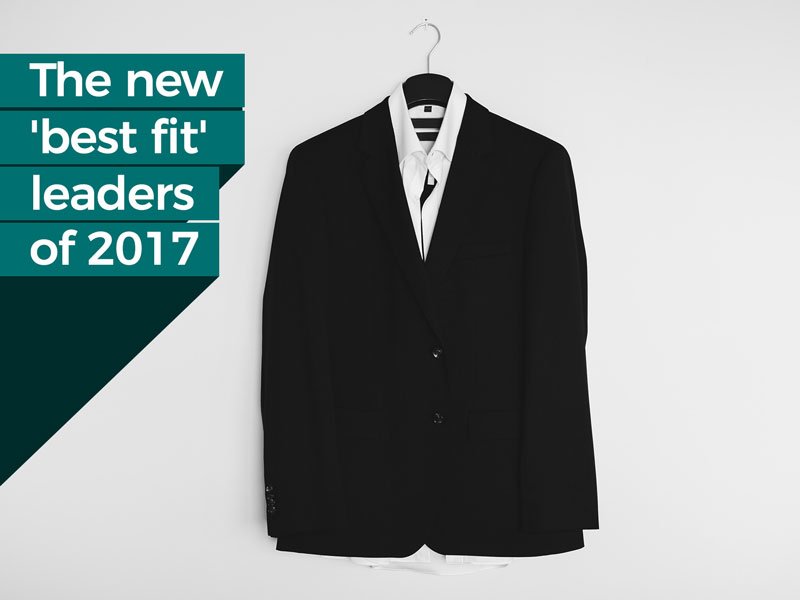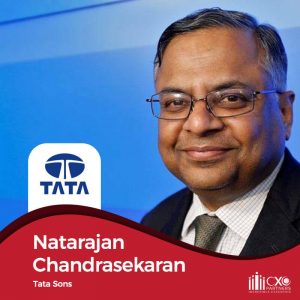Top 10 business leadership changes in 2017

Business and corporate world are dynamic in nature. Each year comes up with new innovations, opportunities, challenges and marketing strategies. Also, there are leadership changes in organizations.
2017 saw quite a few leadership changes and revamping of organizational structure in big companies.
Here are 10 noteworthy leadership changes in 2017 that you should be aware of–
 Natarajan Chandrasekaran – Tata Sons
Natarajan Chandrasekaran – Tata Sons
Tata Sons is the holding company of Tata Group. It is the owner of Tata trademark. TCS generates 70% revenues of Tata Sons. Natarajan Chandrasekaran was CEO of TCS. He took over as Chairman of Tata Sons on February 21, 2017.
Natarajan Chandrasekaran was the best choice for the position as the board said that he has demonstrated exemplary leadership as the Chief Executive Officer and Managing Director of Tata Consultancy Services. The decision to appoint him was taken by five-member search committee including Ratan Tata. Under him, TCS revenues had grown by 24%.
Chandrasekaran was appointed as Chairman after the controversial exit of Cyrus Mistry. There were lot of challenges like protectionism, legacy issues and litigations, but his rich experience in operation made the board appoint him as the new Chairman.
 Salil S. Parekh – Infosys
Salil S. Parekh – Infosys
Infosys, the second largest Indian IT company in 2017, provides information technology and business consulting services.The position of CEO was to be filled after exit of Vishal Sikka. Mr. Salil S. Parekh would be appointed as the new CEO with effect from January 2, 2018.
Mr. Parekh was the right choice for the board as he had a sales background with strong experience in IT industry. Moreover, the appointment needed to be conventional and conservative, as the organization needed stability more than revitalization.
His predecessor, Vishal Sikka allegedly had an acrimonious rancor with the board and Salil Parekh’s appointment entails lot of challenges ahead. He has to ensure growth, crack overseas deals, and more importantly re-stabilize the organization after ‘Sikka Era’. With his attributes and rich experience in IT sector, he seems like a suitable fit for the job.

N. Subrahmanyan – L & T
Larsen & Toubro is an Indian multinational conglomerate with business interests in engineering, construction, manufacturing goods, information technology and financial services. S.N. Subrahmanyan, who was previously serving as Deputy Managing Director and President, was appointed as Managing Director and CEO of L&T with effect from July 1, 2017.
The decision was based on the fact that SNS has immense experience in the company. His predecessor, A.M. Naik had previously said that an executive hired from outside might not be able to lead the company, as it is a complex organization with multiple lines of businesses. Considering that fact, Mr. Subrahmanyan was the best choice.
SNS took charge of L&T in difficult times. Private investment in India had not taken off and there was a slowdown in West Asia due to sudden decrease in oil prices. This saddled the firm with high working capital and low equity return. However, looking at his rich experience in the firm and having A.M. Naik as a mentor, his appointment is legit.

Dara Khosrowshahi – Uber
Uber is a global transportation technology organization. Uber has been a pioneer in sharing economy. It develops, markets and operates Uber car transportation services. Dara was appointed as the new CEO of Uber on August 30, 2017. He succeeded the founder of the firm, Travis Kalanick.
Dara Khosrowshahi an Iranian-American businessman was previously CEO of Expedia Inc. Uber’s search for Kalanick’s replacement was not an easy one. It involved high profile candidates like HP’s Meg Whitman and Facebook’s Sheryl Sandberg. Khosrowshahi was selected looking at the fact that Expedia 13 years ago (when he joined) was similar to what Uber is now. Sales quadrupled in his tenure at Expedia.
Mr. Khosrowshahi was appointed when investors like Benchmark started showing impudence towards Travis. Dara has been facing a number of challenges in his new role. He is looking to improve both bottom line and image of the company. Uber also has been cooperating with a US probe into possible bribery violation. It is a tumultuous time to be appointed as the new CEO.

John L. Flannery – General Electric
General Electric (GE) is an American multinational conglomerate that operates through a diverse range of segments including Aviation, Current, Engineering, Software Development etc. On August 2, 2017, GE marked the official changing of guard when John Flannery took helm as the new CEO.
Flannery was leading the turnaround of GE Healthcare. He had also launched Sustainable Healthcare Solutions. Flannery’s stint in India and his leadership of the company in the most tumultuous times made the investors and board trust his appointment.
John Flannery took over the position of CEO when the company’s stock was struggling. The shares were already down 19%. This is a crucial time for GE as it continues to shift into a pure-play industrial conglomerate with focus on tech. Going by the way Flannery is motivating his employees to create a customer-centric approach and build the best team, GE is surely in the right hands.

Vinay Dube – Jet Airways
Jet Airways is the second largest Indian international full-service airline in India with 17.8% market share. Jet Airways was operating without a full-time CEO since Crammer Ball quit in February 2016. Vinay Dube was appointed as CEO with effect from August 9, 2017.
Mr. Dube was Senior Vice President of Asia Pacific at Delta Airlines, Inc. Previously, he has also served as Vice President of Alliances and Chief Information Officer. Guarang Shetty and Amit Agarwal were acting CEOs before Vinay Dube. The board took its time and appointed Dube after receipt of all requisite government and regulatory approvals.
His appointment came at a time of challenging business conditions for the airline. He is expected to lead the executive management committee and deliver on company’s strategic objectives. He will also be responsible in strengthening relationship with strategic partner Etihad Airways. With his experience in the industry, the decision of hiring him seems right.

Joerg Erlemeier – Nokia
Nokia is a Finnish multinational communications, information technology and consumer electronics company. In 2016, Nokia reported annual revenues of around $23.6 Billion. On December 11, 2017, Nokia appointed Joerg Erlemeier as the Chielf Operating Officer of the group leadership team. He will be reporting to CEO and President, Rajiv Suri.
Joerg has 20+ years of experience in telecommunication industry and particularly in various leadership levels in Nokia. He is known to challenge current operating models and believes in customer satisfaction. He succeeds the former COO Monika Maurer.
Nokia has been struggling in the face of a shrinking market and tough competition. With demand of 4G, the old 2G and 3G network equipment has gone down and demand of 5G equipment is expected soon. Nokia shares had lost almost fifth of their value in October. The new COO will be facing a lot of challenges with it but his predecessor Monika will be supporting him in the transition period.

James Hacket – Ford Motor Company
The Ford Motor Company registered revenue of $151.8 Billion in 2016. James Hacket was appointed as the CEO of Ford with effect from May 22, 2017.
Hacket has served for thirty years in a Grand Rapids-based company, Steelcase. In 1994, he was named CEO at the age of 39. He held the position for nearly 20 years. He succeeded Mark Fields as the President and CEO of Ford Motor Company.
Hacket’s appointment as CEO brings him multiple challenges along with the title. During Fields’ three years tenure as CEO, Ford’s stock dropped 40%. While Ford is facing tough competition from other companies in the same sector, Bill Ford has faith in Hackett’s ability to transform Ford for the future.

James Quincey – The Coca-Cola Company
In 2016, Coca-Cola registered its revenue at $41.38 Billion. James Quincey was appointed as the new CEO with effect from May 1, 2017.
James Quincey had formerly worked with Bain & Co and a smaller consultancy before joining Coca-Cola in 1996. In 2015, he was named as the COO and President of the organization. He succeeded Muhtar Kent who retired in May 2017.
James was reported to be under pressure for cutting the calories of the beverage as an effort towards anti-obesity trend. Consumers in US and other markets are forcing the company to diversify its product. The company is relying less on soda and pushing it to healthier segments. Mr. Quincey is looking into the problem through a realistic lens and is much more transparent about problems that Coca-Cola is facing.

Rosalind Brewer – Starbucks Corporation
Starbucks, an American coffee company and coffeehouse chain with various locations worldwide announced its total revenue at $21.31 Billion in 2016. Rosalind Brewer was appointed as the COO of the organization with effect from October 2, 2017.
Brewer has more than 30 years of experience including 10 years leading multinational retailers. In 2013, she was in the 100 most powerful Women list by Forbes. Previously, she was the CEO of Sam’s club, a division of Wal-Mart Stores Inc. On February 1, 2017, she was nominated for the Starbucks Board of Directors.
Starbucks growth rate has slowed down in recent years, partly because of increasing number of orders made through its mobile app, that the staff is unable to prepare coffee fast enough. This is where Brewer’s relevant experience comes into picture. She is a world class retail operator with a lot of insight from her past experience. She said she will be focusing on improving Starbucks stores by stationing the right people at the right part of the building – without moving away from human elements like greeting the customer.



